|
|
O R A C L E O B S E R V A T O R Y Report 26-27 May 2006 |
|
|
The forecasts for 26 and 27 May at Oracle Observatory were for clear skies but somewhat windy at times (25 MPH, gusting to 40 MPH!). Even with the wind forecast I decided to chance it.
When I arrived at 1315 MST on Friday the temperature was 88°F with clear blue skies. But it was definitive windy. I decided to set up only the tent while waiting to see what the wind did later in the afternoon. By 1450 it was 102° inside the tent but outside it was very comfortable. While waiting I decided to take some pictures of flowers on some of the cactus plants:

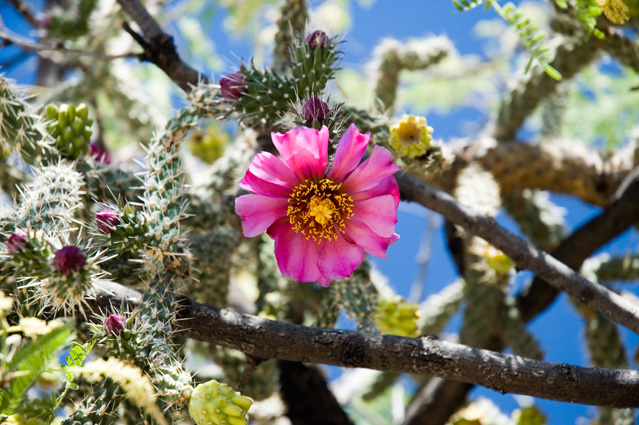

After walking around the property I came back to the tent, which was barely staying upright in the wind:

In fact, at times it was almost flattened by the wind!
I was visited several times by quail who live on the property (I'm just a guest, afterall).
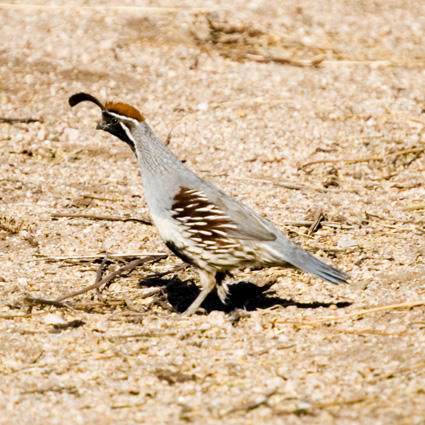
By 1830 MST, with the temperature at 84°, the winds had calmed down enough that I decided to set up the equipment:

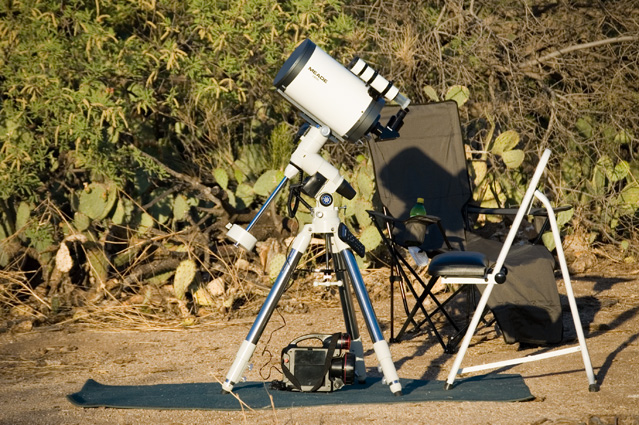
Sunset was gorgeous as the Sun set in a nearly cloud-free sky behind distant mountains. The temperature was 80°. (RAW images taken with my Nikon D70 Digital SLR at 200mm and processed using Adobe Camera Raw, part of Photoshop CS2.)


I spent this first night checking out my new LXD75 mount for visual use. First up was a manual swing of the telescope to view the planet Mercury shortly after sunset. Mercury was a bright disk but affected by its low altitude and so presented lots of color refraction. After some stars began to appear about 2020 I decided to do my first alignment with the LXD75. I did a One Star alignment to align the polar axis on True North. Then I did an Easy Two Star alignment to refine the pointing accuracy of the Autostar (version 4.2Ed). First GOTO was to Jupiter and the LXD75 placed it directly in the center of the 26mm (77X) eyepiece. I spent some time just looking at Jupiter in 26mm (77X), 12.4mm (161X), and 6.4mm (312X) eyepieces. I used a Meade #905 Variable Polarizer Filter to reduce the glare from the planet, which helped a lot in seeing details in the cloud bands. Easily seen were multiple cloud bands, some dark spots, and of course, the four Jovian moons. I then did a GOTO Saturn, which was too low in the sky to observe using the 6.4mm eyepiece but it was nice in the 12.4mm eyepiece. One cloud band and the planet's shadow on the Ring system were visible.
Next up was Mars; small red disk with no features visible. I then went to M13, the Great Globular Cluster in Hercules. Very pretty with lots of stars visible in the 26mm eyepiece. I then switched to a Tele Vue 35mm Panoptic (57X) 2" eyepiece. It was a beautiful sight! I then observed the galaxies M101, M81, M82, and M51. Now that twilight had finally ended I did a "Tonight's Best" guided tour with the Autostar controller. I looked at many galaxies and star clusters. I was able to observe the Omega Centauri globular cluster, which was very low in the southern sky and just visible through some tree branches. It was still an exciting object to see since I rarely get to view it. I then took a look at M57, the Ring Nebula. Just lovely. Last for the night was Jupiter, which was centered again after the GOTO. By this time the Great Red Spot had rotated into view and was easily seen. But I didn't see its new "baby brother".
During most of the night I listened to music on my iPod mini. One of the best stargazing albums is "Galaxies" from the Hearts of Space. Many of the HOS albums make great music to watch the stars by!
It had been a long day (I left home at 0450 PDT) and I was getting tired. So I closed up shop for the night at 2320. The winds had been kicking up at times and were still forecast to be around on Saturday so I moved all the equipment (except the LXD75 mount itself) and other items into the tent.
Saturday, the 27th, was a beautiful but VERY windy day. Mid-morning I set up my PST (Personal Solar Telescope) on a camera tripod since the 8"SC was still in the tent due to the winds.

Two small sunspots were visible along with several active regions and one nice prominence on the limb. While observing the Sun I used my Solio solar charger to charge up my iPod mini after its many hours of use the previous night. This is a really handy device for use in the desert! I fully charged the iPod in 2 hours, which set me up nicely to listen to more stargazing music at night.
During the afternoon there was a hawk flying around at a fairly high altitude:

Shortly before sunset the winds calmed down a little bit so I set up the 8"SC for the night's astrophotography tests with my new LXD75 mount. Here you can see my ETX-90 telescope piggybacked on the 8"SC as a Guidescope. It turned out that I rarely needed to use it due to the tracking accuracy of the new mount.

Sunset was very pretty. Here is a sequence of pictures taken with a 55-200mm zoom lens on the Nikon D70 DSLR:
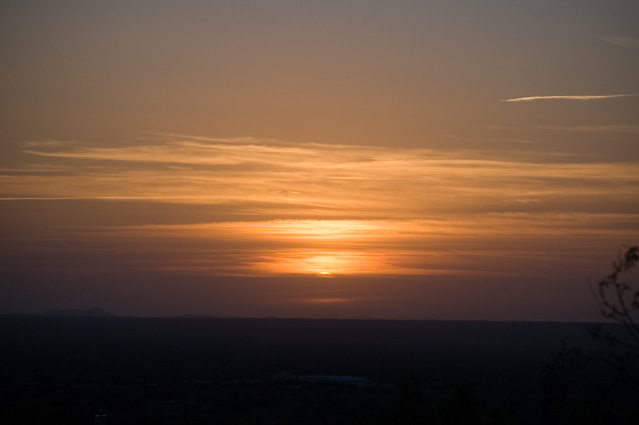




A few minutes after sunset I managed to locate a very new Moon (21 hours 18 minutes old) in 7x50 binoculars. It was a fascinating sight, rarely seen. This is the youngest Moon I personally have ever seen. Here are two shots showing what the Moon looked like through the 8"SC (taken with the D70 at Prime Focus). The first photo was taken while the sky was still very light and the second a few minutes later with darker skies.


Besides this young Moon, I also got to see Mercury, which was in the same FOV in the binoculars. Nice!
Shortly after sunset the winds died down completely and stayed that way all night long. Whew! So I went ahead with some Prime Focus astrophotography through the 8"SC using the D70 DSLR. Here is M13, the Great Globular Cluster in Hercules. This was a 1 minute, ISO 1600, Noise Reduction ON, RAW exposure with no manual guiding corrections.

And M57, the Ring Nebula in Lyra, also 1 minute, ISO 1600, NR ON, RAW exposure with no guiding corrections.

Here is M4, another star cluster, taken the same as the above.
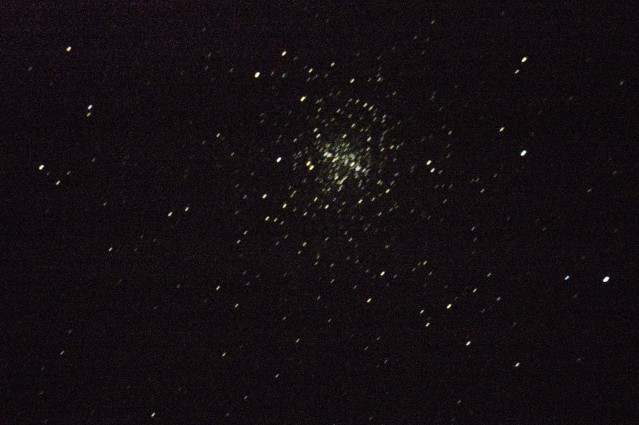
And last, a 1 second, ISO 400, NR ON, RAW exposure of the beautiful double star Albireo, showing its yellow and blue stars.

Due to the winds keeping me awake most of the night before I was very tired and decided to get some good sleep before driving the 8.5 hours back home the next day. I closed up the "observatory" at 2230 MST under a starry night, no wind, and a temperature of 66°F. I slept good that night, knowing that this trip to Oracle Observatory and my tests of the new LXD75 mount were successful.
Return to the top of this page.
Return to the Oracle Observatory Main Page.